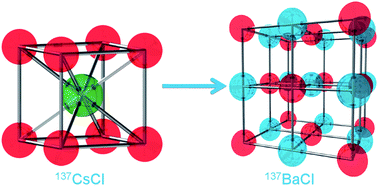Recently, using first principles theoretical methods, we have predicted that unconventional compounds and crystal structures may form via the chemical transmutation that occurs during radioactive decay (e.g. rock salt 137BaCl formation from the β- decay of 137CsCl) (C. Jiang, C.R. Stanek, N. A. Marks, K. E. Sickafus and B. P. Uberuaga, Phys. Rev. B: Condens. Matter Mater. Phys., 2009, 79, 132110). We refer to this phenomenon as “radioparagenesis”. In this paper, we explore the concept of applying radioparagenesis to the evaluation of long time scale crystalline nuclear waste form performance as well as to the design of chemically robust waste forms. For waste form evaluation, we specifically discuss: (1) the variation in the properties of radioparagenetic phases that govern waste form performance, as compared to conventional materials, (2) the volumetric change associated with radioparagenetic phase formation (using Cs1−xBaxCl as an example), which may lead to waste form cracking and (3) thermodynamic and mechanical stability of radioparagenetic phases. For waste form identification, we introduce the possibility of “backward design”, where the chemical evolution of the waste form is explicitly considered with the goal of achieving a defined end state. The decay of 90SrO2 to 90ZrO2 is provided as a demonstrative example. We use density functional theory to examine the performance and design of waste forms. Finally, we propose accelerated experiments to rapidly verify the formation of radioparagenetic phases, which has not occurred to date.


 Please wait while we load your content...
Please wait while we load your content...